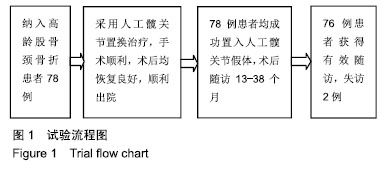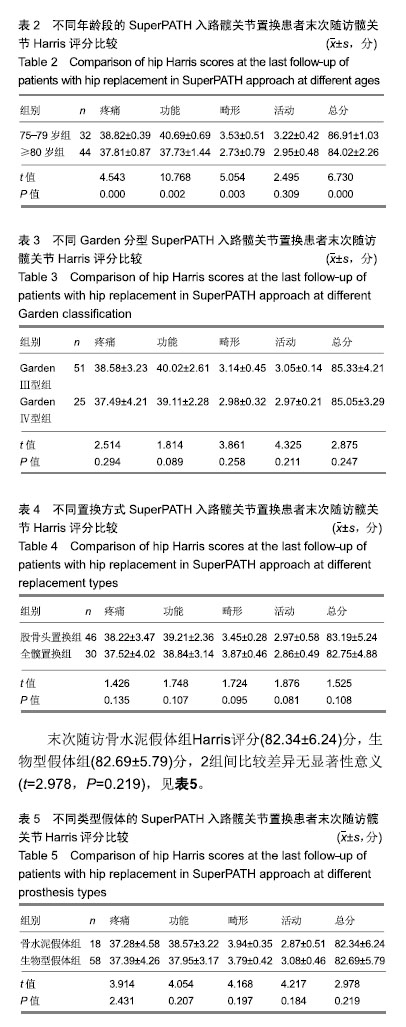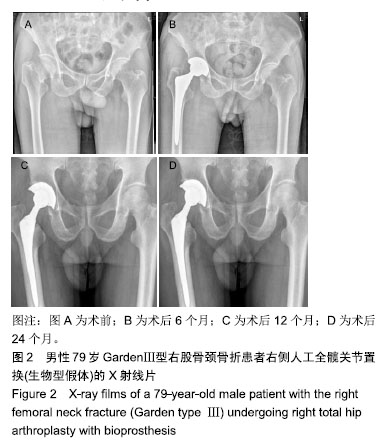| [1]Bodrogi AW, Sciortino R, Fitch DA, et al.Use of the supercapsular percutaneously assisted total hip approach for femoral neck fractures: surgical technique and case series.J Orthop Surg Res. 2016;11(1) : 113.[2]Della Torre PK ,Fitch DA,Chow JC.Supercapsular percutaneously- assisted total hip arthroplasty:radiographic outcomes and surgical technique. Ann Transl Med. 2015;3(13):180.[3]Meller MM,Toossi N,Gonzalez MH,et al.Surgical risks and costs of care are greater in patients who are super obese and undergoing THA.Clin Orthop Relat Res. 2016;474(11):2472-2481.[4]Chow J,Penenberg B,Murphy S.Modified micro-superior percutaneously assisted total hip: early experiences&case reports.Curr Rev Musculoskelet Med. 2011;4(3):146-150.[5]Chow J, Fitch DA. In-hospital costs for total hip replacement performed using the supercapsular percutaneously-assisted total hip replacement surgical technique.Int Orthop. 2017;41(6):1119-1123.[6]姚坚,丁海.SuperPath微创人工全髋关节置换术的研究进展[J].中国修复重建外科杂志,2016,30(9):1170-1173.[7]徐果飞,胡力,杨书华,等. SuperPATH微创入路人工股骨头置换术治疗老年股骨颈骨折的短期随访研究[J].海南医学, 2018,29(17):2400-2404.[8]乔高山,朱成栋,朱乐银,等.SuperPATH微创与常规入路行全髋关节置换术的早期疗效比较[J].生物骨科材料与临床研究,2018,15(1):52-54.[9]胡方煜,赖仁欢,梁木荣,等.SuperPATH入路微创人工全髋关节置换术的临床应用[J].微创医学,2016,11(3):416-418.[10]樊晓臣,章洪喜.SuperPath微创人工全髋关节置换术治疗股骨头坏死1例报告[J].江苏大学学报(医学版),2016,26(1):91-92.[11]Capuano N,Del Buono A,Maffulli N. Tissue preserving total hip arthroplasty using asuperior capsulotomy. Oper Orthop Traumatol. 2015;27(4):334-341.[12]Rasuli KJ, Gofton W. Percutaneously assisted total hip (PATH) and Supercapsular percutaneously assisted total hip (SuperPATH) arthroplasty: learning curves and early outcomess. Ann Transl Med. 2015;3(13):179.[13]Abe K,Yuda S,Yasui K,et al.Soleal vein dilatation assessed by u1trasonography is an independent predictor for deep vein thrombosis after major orthopedic surgery. J Cardiol. 2017;69(5):756-762. [14]孙彦平,刘月坤,崔晓亮,等.Superpath全髋置换与全髋关节置换术的疗效、疼痛程度及髋关节功能分析[J].中华骨与关节外科杂志,2017, 10(4):305-307.[15]黄钢勇,夏军,魏亦兵,等.SuperPATH 入路髋关节置换术治疗高龄老年股骨颈骨折短期临床疗效[J].国际骨科学杂志, 2016,37(5):331-336.[16]佟大可,贺倩芸,刘康,等.SuperPATH入路髋关节置换术治疗股骨颈骨折的短期疗效评价[J].中国骨与关节损伤杂志, 2017,32(3):308-310.[17]Xie J, Zhang H, Wang L, et al.Comparison of supercapsular percutaneously assisted approach total hip versus conventional posterior approach for total hip arthroplasty a prospective, randomized controlled trial. J Orthop Surg Res. 2017;12(1):138.[18]Leunig M, Faas M, von Knoch F, et al. Skin crease ‘bikini’ incision for anterior approach total hip arthroplasty: surgical technique and preliminary results. Clin Orthop Relat Res. 2013;471(7): 2245-2252. [19]Mehrotra A,Sloss EM,Hussey PS,et al.Evaluation of a centers of excellence progrom for knee and hip replacement. Med Care. 2013; 51(1):28-36.[20]李锦英,李丽娟,危友华,等老年患者髋关节置换手术的麻醉护理配合体会[J].当代医学,2012,18(16):116-117.[21]林凯生,蔡吟环.髋关节置换手术患者局部纤溶活性指标的变化[J].现代医院,2012,12(9):19-22.[22]任东伟,杨革军,赵华磊,等. SuperPATH切口微创人工全髋关节置换术对股骨头坏死疗效及生活质量的影响[J].河北医科大学学报, 2016,37(12): 1416-1419.[23]吴良浩,禹宝庆,陈帆成. SuperPATH微创入路人工股骨头置换治疗老年股骨颈骨折: 前瞻性?开放性?随机对照临床试验[J].中国组织工程研究, 2017,21(7):1009-1014.[24]王坤正. 浅谈中国关节置换外科的现状与未来[J].中华关节外科杂志(电子版), 2015, 9(6): 703-706.[25]Penenberg BL, Bolling WS, Riley M. Percutaneously assisted total hip arthroplasty (PATH): a preliminary report. J Bone Joint Surg(Am). 2008; 90 Suppl 4: 209-220.[26]颜廷题,田少奇,王远贺,等. SuperPATH 与 Hardinge 入路全髋关节置换术早期临床疗效比较[J].中国修复重建外科杂志,2017,31(1):17-24.[27]何启新,乔巨峰,刘永青. SuperPath微创人工全髋关节置换术与常规全髋关节置换术早期疗效比较[J].广东医学院学报,2016,34(3):289-291.[28]吴长坤,姜任东,杨波,等. SuperPATH 与后外侧入路全髋关节置换术临床疗效比较[J].中国矫形外科杂志,2018,26(15):1360-1364. |





